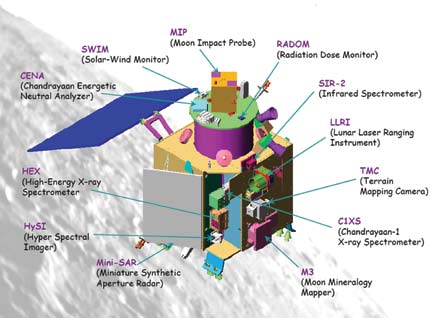Scientific payloads
The indigenously developed payloads are:
1. Terrain-mapping stereo camera in the panchromatic band, having 5m spatial resolution and 20km swath
2. Hyper-spectral imaging camera operating in the 400-950nm band with a spectral resolution of 15 nm and spatial resolution of 80 metres with a swath of 20 km
3. Lunar laser-ranging instrument with height resolution of about 10 metres
4. High-energy X-ray spectrometer using cadmium-zinc-telluride (CdZnTe) detector in the 30-250 keV energy region with spatial resolution of 40 km
5. Moon impact probe as piggyback on the main orbiter of the Chandrayaan-1 spacecraft which impacted on the surface of the moon
The imported payloads on-board Chandrayaan-1 are:
1. Chandrayaan-1 X-ray spectrometer through ESA—a collaboration between Rutherford Appleton Laboratory, the UK and ISRO Satellite Centre, ISRO. Part of this payload was redesigned by the ISRO to suit scientific objectives of Chandrayaan-1
2. Near-infrared spectrometer (SIR-2) from Max Plank Institute, Lindau, Germany, through ESA
3. Sub-keV atom-reflecting analyser through ESA, from Swedish Institute of Space Physics, Sweden, and Space Physics Laboratory, Vikram Sarabhai Space Centre, ISRO. The data processing unit of this payload was designed and developed by the ISRO, while Swedish Institute of Space Physics developed the payload
4. Radiation-dose monitor from Bulgarian Academy of Sciences
5. Miniature synthetic aperture radar (MiniSAR) from Applied Physics Laboratory, Johns Hopkins University, and Naval Air Warfare Centre, USA, through NASA
6. Moon mineralogy mapper from Brown University and Jet Propulsion Laboratory, USA, through NASA
Moon impact probe
The moon impact probe is slightly smaller than a TV cabinet and weighs a bit more than a school-going kid, but there’s a lot tucked away inside it. The MIP detached from the Chandrayaan a 100 km above the moon. The 29kg moon impact probe—a payload developed by the Vikram Sarabhai Space Centre at Thiruvananthapuram—will help identify future landing sites on the moon and also aid in scientific exploration of the lunar surface. The dimensions of the impact probe are 375×375×470 mm3.
The three major payloads in the MIP are:
1. Radar altimeter to measure the altitude of the moon impact probe above the lunar surface and qualify technologies for future landing missions. The operating frequency band is 4.3 GHz±100 MHz
2. Video imaging system to acquire images of the surface of the moon from the descending probe. The video imaging system consists of an analogue CCD camera along with a video decoder
3. A state-of-the-art quadrupole mass spectrometer with a mass resolution of 0.5 amu. It is sensitive to partial pressure of the order of 10-15 torr for measuring the constituents of tenuous lunar atmosphere during descent
In addition to the instruments, the separation system, the de-boost spin and de-spin motors, it comprises the avionics system and thermal control system. The avionics system supports the payloads and provides communication link between the moon impact probe and the main orbiter, from separation to impact, and provides a database useful for future soft landing. The mission envisages collection of all the instrument data during descent and transmission to the main orbiter, which, in turn, will transmit it to the ground station during visible phases.

Mission objectives
1. To harness the science payloads, lunar craft and the launch vehicle with suitable ground support systems including deep space station
2. To realise the integration and testing, launch into the lunar polar orbit of about 100 km, in-orbit operation of experiments, communication/telecommand, telemetry data reception, quick-look analysis of data and archival for scientific utilisation by an identified group of scientists
Scientific objectives
The Chandrayaan-1 mission is aimed at high-resolution remote sensing of the moon in visible, near-infrared, low-energy X-ray and high-energy X-ray regions. Specifically, the objectives are:
1. To prepare a three-dimensional atlas (with a high spatial and altitude resolution of 5-10 metres) of both near and far sides of the moon
2. To conduct chemical and mineralogical mapping of the entire lunar surface for distribution of elements such as magnesium, aluminium, silicon, calcium, iron and titanium with a spatial resolution of about 25 km and high-atomic-number elements such as radon, uranium and thorium with a spatial resolution of about 20 km
Simultaneous photo geological and chemical mapping will enable identification of different geological units, which will test the early evolutionary history of the moon and help in determining the nature and stratigraphy of the lunar crust.
Next in line: Chandrayaan-2
ISRO is also planning a second version of Chandrayaan named Chandrayaan- 2. According to ISRO chairman G. Madhavan Nair, “The ISRO hopes to land a motorised rover on the Moon in 2012, as a part of its second Chandrayaan mission. The rover will be designed to move on wheels on the lunar surface, pick up samples of soil or rocks, do on-site chemical analysis and send the data to the mother-spacecraft Chandrayaan-2, which will be orbiting above. Chandrayaan-2 will transmit the data to the earth.”
The author is from Department of Physics, S.L.I.E.T. (deemed to be university), Longowal, Distict Sangrur, Punjab






